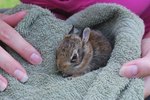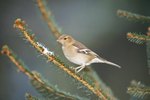
The best thing you can do to help orphaned raccoons or any other wild animal is to leave it to the experts. Learning the location and contact information of your local wildlife rehabilitation center may be all you can do. It takes a special skill to raise an orphaned baby animal, particularly a wild one.
Truly Orphaned?

David Hitzig, executive director of Busch Wildlife Hospital in Florida, has good advice for anyone who believes they have found a baby animal: "Unless the baby is in imminent danger, leave it alone," He says. "The mother may have just wandered away and is awaiting your departure so she can come back." It's common for racoons to have two nests. Mom may be moving the babies and is coming right back. Hitzig recommends you leave the baby alone and come back in 12 hours unless the animal is injured or the weather is very cold, in which case you'd come back in two hours. Don't leave the baby out in the open where it can be found by a bird of prey; tuck it under nearby shrubbery. If the baby is still there when you come back, you can assume it has been abandoned.
Body Condition

A clue to determining whether a creature is truly abandoned is the presence of ants, flies, fly eggs and ticks on the body. If the baby has obvious injuries such as a broken leg, profuse bleeding, extreme lethargy, strange behavior such as walking in circles, or a noticeable head tilt, you will need to find a veterinarian who will euthanize it right away unless there is a rehab facility nearby. If a rehab facility is too far away to drive to, call and get detailed instructions for proceeding. Wearing gloves to protect you from bites, gently wipe off dirt and external parasites with a warm washcloth. Keep the babies warm. If the baby's eyes are open, he already has the beginnings of teeth, so use extra care. Raccoons carry rabies, so be extra careful around kits with teeth.
Supplies

Fit a baby bottle with a "preemie" baby bottle nipple. Fill it with Pedialyte, as you will need to rehydrate the baby before you can begin to feed him. After three or four feedings of Pedialyte 30 minutes apart, offer replacement milk. Purchase the brand KMR, which is kitten replacement formula, as it is best suited for baby raccoons. After each feeding, stimulate the baby's genitals with a warm, moist washcloth to encourage elimination.
Housing

Kits should be housed together in an area big enough to designate a potty area. Line this spot with shredded paper and place a bit of leavings there. The kits will soon get the idea. Wean at about 6 weeks of age by offering puppy chow soaked in KMR or apple juice. In time you can add fruits to the mixture. Always supply fresh water. Don't allow them to bond with you, or yourself with them -- their release back into the wild should be your goal. Taking away their fear of humans puts them at a disadvantage in life. Take them for supervised walks and allow them to "find" bits and pieces of natural foods such as seeds, nuts and fruit. Move their safe and enclosed housing outside when they are about 8 weeks of age, and plan to release them two to three weeks after that.
References
Photo Credits
-
Hemera Technologies/Photos.com/Getty Images
Writer Bio
Michelle A. Rivera is the author of many books and articles. She attended the University of Missouri Animal Cruelty School and is certified with the Florida Animal Control Association. She is the executive director of her own nonprofit, Animals 101, Inc. Rivera is an animal-assisted therapist, humane educator, former shelter manager, rescue volunteer coordinator, dog trainer and veterinary technician.




